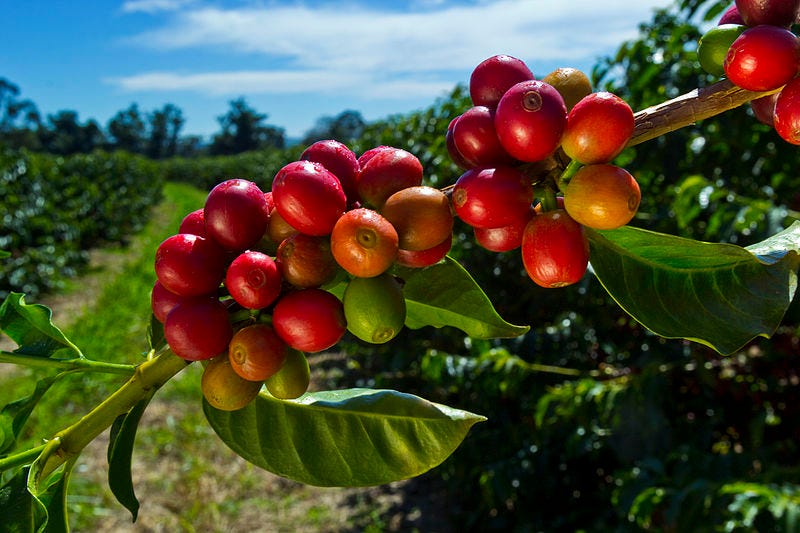Decoding the Mysterious Sweetness of Coffee
Roasted coffee has no sugar, but the best coffees taste sweet. What gives? Science explains.
The first time a coffee lover visits a coffee farm, it’s a big moment. Suddenly, they are confronted with a coffee tree. And growing on the branches are not brown beans nor a steaming beverage, but are instead bright red berries. If they pluck a berry and taste it, they will be treated to a sweet, juicy flavor that tastes a little like melon and jasmine. It comes as a revelation: coffee is a fruit.
This epiphany is so powerful to coffee people that it has led to an entire philosophy about coffee’s identity as a fruit. “Fruits are sweet,” the philosophy goes, “and that’s why coffee is sweet.”
There is a lot of truth in this, but it’s also more complicated. Let’s explore the source of sweetness in coffee.
To begin with, coffee can be sweet. Consumers and professional tasters alike detect sweetness in unsugared coffee, and value it highly when they encounter it. Evaluating sweetness has been an important part of coffee tasting protocols for decades. Roasting companies revere sweetness, celebrating its existence on their labels. There is no question that the “natural sweetness” in coffee is valuable, exciting, perceptible and very very real.
The only thing is: roasted coffee has almost no sugar. Sugars exist in the raw seed, but they are destroyed by heat, which breaks them down into various other compounds. Any residual sugars left in the roasted bean are far below the threshold of human detection and provide no calories. But it gets weirder. Studies of sweetness in coffee show that its perception is most evident when the strength of the coffee is lowest. That means that the easiest way to enhance a coffee’s natural sweetness is to make it weak and- in coffee terms- underextracted. This is the opposite of what you would expect if coffee’s sweetness came from sugars.
So what is coffee sweetness all about? Well, it’s clearly associated with the phenomenon of sweetness overperception that I wrote about here. (if you haven’t yet read that article yet, please do- it’ll help you understand this one) If sweetness perception is the human capacity to detect sugar, it is giving us a false positive in coffee’s case. But is it an illusion, really?
Well, to begin with, human perception of sweetness in coffee is reliably perceptible by tasters. Coffee experts were shown to repeatably and consistently order coffees from sweetest to least sweet. When the same tasters were asked to perform the same task with a nose clip, they can still do it, but with more difficulty. This shows that the sweetness in coffee has a strong aromatic component. But it also suggests that aroma isn’t the whole story. Coffee smells sweet, but it tastes sweet too. The same researchers are currently looking for chemical markers of sweetness in coffee, but they haven’t yet published their results. So, from a chemical perspective, we don’t yet know what causes coffee sweetness.
But our natural chemistry detectors- our senses of taste and smell- can give us clues. Let’s begin with the favorite tool of coffee tasters- the flavor wheel. Sweetness appears in three sections on the upper-right of the wheel, in the categories “sweet”, “floral”, and “fruity”.
As I previously wrote, several sweet-smelling aromatics in coffee come from browning reactions, including the Maillard reactions. Caramel, maple, molasses, and most crucially vanilla aromas are produced during browning. These compounds- known as “sweet aromatics” to coffee tasters- are critical in driving the perception of sweetness among almost everyone.
Moving clockwise around the flavor wheel, we hit the floral aromatics. Flowers can be intensely sweet-smelling: think of honeysuckle or gardenia (a botanical relative of coffee. The floral notes we encounter most in coffee are black tea, chamomile, rose and jasmine, which are all sweet in different ways.
Finally, the fruits. Fruit aromatics have been shown to be less powerful than vanilla in triggering sweetness perception, but nevertheless fruit aromatics can be a trigger of “sweet” in beverages. A good example of this is in unsweetened flavored soda waters- a passionfruit or cherry La Croix will trigger perceptions of sweetness. So it is in coffee- an aromatic note of berry or apple or peach can evoke powerful memories- and, later, perceptions, of sweetness in coffee.
So, these aromatics- perceived by the nose- can drive the sensation of sweetness. But what about tastes, perceived on the tongue? It seems likely that there are sweet-tasting nonsugar compounds in coffee- though the specific chemistry has not yet been identified, the indications seem clear that there that these sweet-tasting molecules exist. But, perhaps even more powerful is the role of bitterness. It’s long been known that bitterness and sweetness suppress each other: a bit of sugar in a bitter drink will make it seem less so, and a splash of bitters in a sweet drink will reduce the perceived sweetness. Bitterness is a common taste attribute in coffee, of course, and when it appears it will logically suppress any sense of sweetness that exists. Also, the opposite: if expected bitterness fails to appear in coffee, it may be perceived as sweetness. In this way, we can think of sweetness perception in coffee as a kind of “anti-bitterness”; an absence of bitterness in coffee may be perceived as sweetness. Indeed, in coffee studies, bitterness and sweetness seem to be powerfully inversely correlated, suggesting that an inverse relationship between the two tastes may exist.
Vanilla, sweet aromatics, fruitiness, floral, bitterness… the drivers of sweetness in coffee are many and they are complex. Perhaps this complexity explains the obsession with sweetness that many coffee people display- we love what we aspire to understand.





